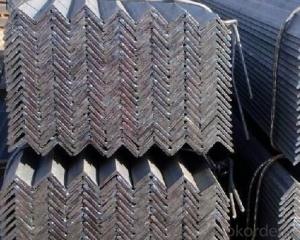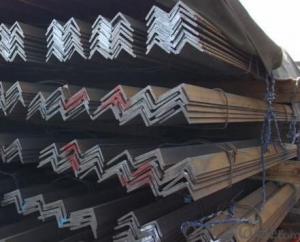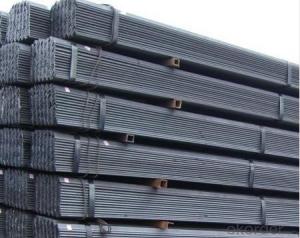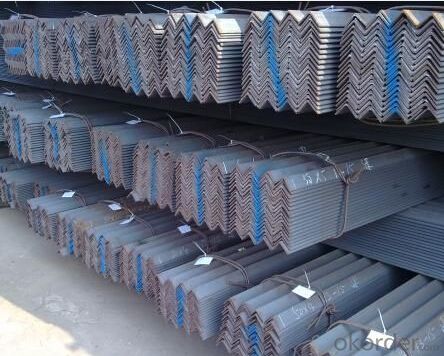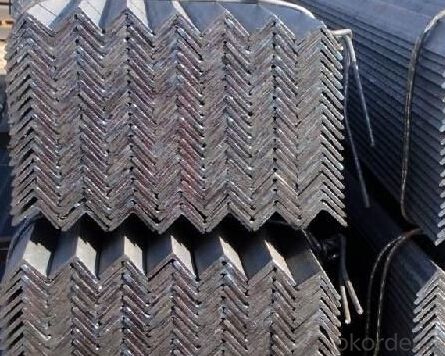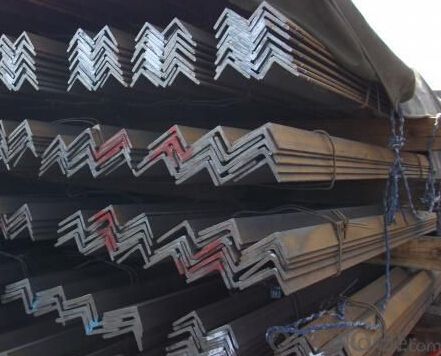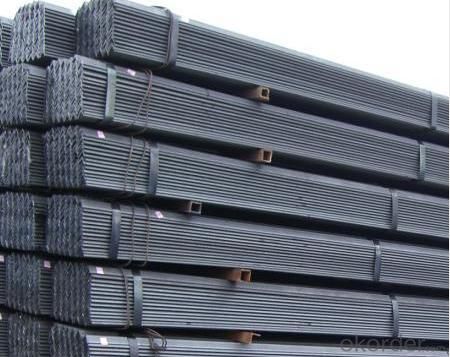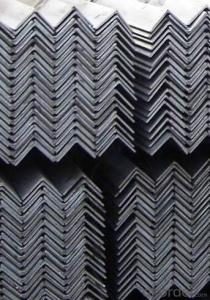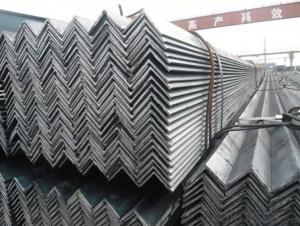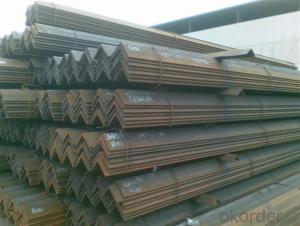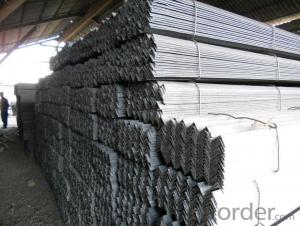Angle Steel with Material: GB Q235B, Q345B
- Loading Port:
- China main port
- Payment Terms:
- TT or LC
- Min Order Qty:
- 100 m.t.
- Supply Capability:
- 5000 m.t./month
OKorder Service Pledge
OKorder Financial Service
You Might Also Like
Product Description:
OKorder is offering Angle Steel with Material: GB Q235B, Q345B at great prices with worldwide shipping. Our supplier is a world-class manufacturer of steel, with our products utilized the world over. OKorder annually supplies products to European, North American and Asian markets. We provide quotations within 24 hours of receiving an inquiry and guarantee competitive prices.
Product Applications:
Angle Steel with Material: GB Q235B, Q345B are ideal for structural applications and are widely used in the construction of buildings and bridges, and the manufacturing, petrochemical, and transportation industries.
Product Advantages:
OKorder's Angle Steel with Material: GB Q235B, Q345B are durable, strong, and resist corrosion.
Main Product Features:
· Premium quality
· Prompt delivery & seaworthy packing (30 days after receiving deposit)
· Corrosion resistance
· Can be recycled and reused
· Mill test certification
· Professional Service
· Competitive pricing
Product Specifications:
1. Standards: GB,ASTM,BS,AISI,DIN,JIS
2. Invoicing on theoretical weight or actual weight as customer request
3. Material:Material: GB Q235B, Q345B or Equivalent; ASTM A36; EN 10025, S235JR, S355JR; JIS G3192, SS400; SS540.
4. Sizes:
Sizes: 25mm-250mm | ||
a*t | ||
25*2.5-4.0 | 70*6.0-9.0 | 130*9.0-15 |
30*2.5-6.6 | 75*6.0-9.0 | 140*10-14 |
36*3.0-5.0 | 80*5.0-10 | 150*10-20 |
38*2.3-6.0 | 90*7.0-10 | 160*10-16 |
40*3.0-5.0 | 100*6.0-12 | 175*12-15 |
45*4.0-6.0 | 110*8.0-10 | 180*12-18 |
50*4.0-6.0 | 120*6.0-15 | 200*14-25 |
60*4.0-8.0 | 125*8.0-14 | 250*25 |
5. Material details:
Alloy No | Grade | Element (%) | |||||
C | Mn | S | P | Si | |||
|
|
|
|
|
|
| |
Q235 | B | 0.12—0.20 | 0.3—0.7 | ≤0.045 | ≤0.045 | ≤0.3 | |
|
|
|
|
|
|
| |
Alloy No | Grade | Yielding strength point( Mpa) | |||||
Thickness (mm) | |||||||
≤16 | >16--40 | >40--60 | >60--100 | ||||
≥ | |||||||
|
|
|
|
|
| ||
Q235 | B | 235 | 225 | 215 | 205 | ||
Alloy No | Grade | Tensile strength (Mpa) | Elongation after fracture (%) | ||||
Thickness (mm) | |||||||
| ≤16 | >16--40 | >40--60 | >60--100 | |||
≥ | |||||||
|
|
|
|
|
|
| |
Q235 | B | 375--500 | 26 | 25 | 24 | 23 | |
Usage & Applications of GB Q235 Angle Steel
Trusses;
Transmission towers;
Telecommunication towers;
Bracing for general structures;
Stiffeners in structural use.
Packaging & Delivery of GB Q235 Angle Steel
1. Transportation: the goods are delivered by truck from mill to loading port, the maximum quantity can be loaded is around 40MTs by each truck. If the order quantity cannot reach the full truck loaded, the transportation cost per ton will be little higher than full load.
2. With bundles and load in 20 feet/40 feet container, or by bulk cargo, also we could do as customer's request.
3. Marks:
Color mark: There will be color marking on both end of the bundle for the cargo delivered by bulk vessel. That makes it easily to distinguish at the destination port.
Tag mark: There will be tag mark tied up on the bundles. The information usually including supplier logo and name, product name, made in China, shipping marks and other information request by the customer.
If loading by container the marking is not needed, but we will prepare it as customer request.
FAQ:
Q1: Why buy Materials & Equipment from OKorder.com?
A1: All products offered byOKorder.com are carefully selected from China's most reliable manufacturing enterprises. Through its ISO certifications, OKorder.com adheres to the highest standards and a commitment to supply chain safety and customer satisfaction.
Q2: How do we guarantee the quality of our products?
A2: We have established an advanced quality management system which conducts strict quality tests at every step, from raw materials to the final product. At the same time, we provide extensive follow-up service assurances as required.
Q3: How soon can we receive the product after purchase?
A3: Within three days of placing an order, we will begin production. The specific shipping date is dependent upon international and government factors, but is typically 7 to 10 workdays.
A4: Stainless steel must contain at least 10.5 % chromium. It is this element that reacts with the oxygen in the air to form a complex chrome-oxide surface layer that is invisible but strong enough to prevent further oxygen from "staining" (rusting) the surface. Higher levels of chromium and the addition of other alloying elements such as nickel and molybdenum enhance this surface layer and improve the corrosion resistance of the stainless material.
Q5: Can stainless steel rust?
A5: Stainless does not "rust" as you think of regular steel rusting with a red oxide on the surface that flakes off. If you see red rust it is probably due to some iron particles that have contaminated the surface of the stainless steel and it is these iron particles that are rusting. Look at the source of the rusting and see if you can remove it from the surface.
Images:
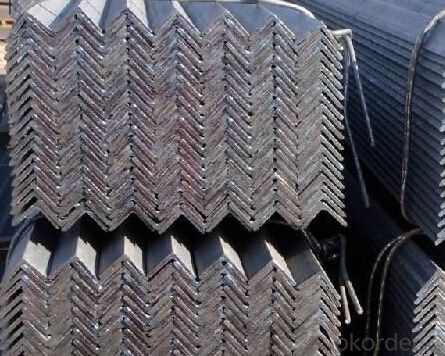
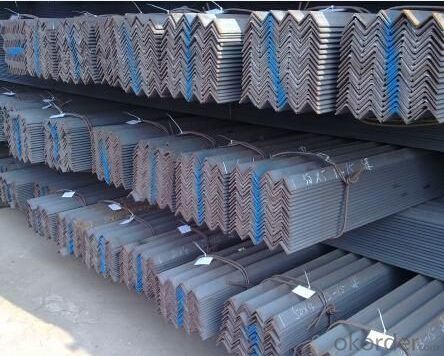
"The angle is perpendicular to each other on both sides of the steel strip into the corner. There are equilateral angle steel and unequal angle points. An equal angle two edge width equal.
The angle is built with carbon steel, is a simple section steel steel, mainly used for metal components and the frame of the plant. In the use of the requirements are good, plastic deformation properties and a certain mechanical strength. The production of raw materials for low carbon steel billet steel billets, finished angle for the hot rolling, normalizing or hot-rolled state of delivery.
The specifications are expressed by the MM number of edges and sides and the thickness of the thick. Such as ""/ 30 x 30 x 3"", that is 30 mm equilateral angle edge width edge thickness was 3 mm. Also available models that model is the number of centimeters wide, such as angle 3#. Model doesn't mean thickness angle of different size in the same model, thus in the edge of the contracts and other documents will be angle width, edge thick size fill in complete, avoid separate model, said. The specifications for 2#-20# hot rolled equilateral angle steel.
The surface quality of the equilateral angle steel are specified in the standard and may not generally require the use of harmful defects, such as delamination, scarring, and cracks. Equilateral angle geometry error allowed range in the standard also provides, in general, including bending, edge width, edge thickness, dip angle and theoretical weight, and provides significant torsional angle not.
Angle according to the different needs of structure composed of a variety of stress components, can also be used as a component of the connections between the. Angle steel is mainly used for manufacturing the frame structure, such as high voltage transmission tower, steel structure bridge girder on both sides of the framework, tower crane of the column and arm lever on the construction site, workshop of column and beam, small place such as festivals roadside put pot in the shape of a shelf, in window hanging solar air conditioning such as shelves.
"
- Q: How do you determine the required size of a steel angle for a specific application?
- There are several factors to consider when determining the necessary size of a steel angle for a particular application. These factors include the load or weight the angle will support, the distance between supports, and the material properties of the steel angle. The first step is to determine the load or weight that the angle will bear. This can be done by calculating the total load applied to the angle, including any objects or structures it will support. It is important to account for static and dynamic loads, as well as potential impact or wind loads. Next, the distance between supports must be taken into account. This is the length over which the angle will span and bear the load. Longer spans typically require larger and stronger angles to maintain structural integrity. Furthermore, the material properties of the steel angle are crucial in determining its necessary size. Steel angles come in different grades and strengths, each with varying load-bearing capacities. It is important to consult engineering and design codes, such as the AISC Manual, to determine the appropriate grade of steel angle that can withstand the calculated load. Once the load, span, and material properties are determined, engineering calculations can be performed to select the necessary size of the steel angle. These calculations typically involve evaluating the angle's moment, shear, and deflection under the applied load. Design tables and equations from the AISC Manual can be used to determine the appropriate size and shape of the angle based on these calculations. To conclude, determining the necessary size of a steel angle for a specific application involves considering the load, span, and material properties of the angle. By performing engineering calculations and referring to design codes, the appropriate size of the angle can be selected to ensure structural safety and integrity.
- Q: Are steel angles cost-effective?
- Yes, steel angles are cost-effective. Steel angles are widely used in various industries and construction projects due to their versatility and durability. They are highly cost-effective because they are easy to manufacture, readily available, and have excellent strength-to-weight ratios. Steel angles also have a long lifespan, reducing the need for frequent replacements or repairs, which can save on maintenance costs in the long run. Additionally, steel angles are recyclable, making them an environmentally friendly and sustainable choice. Overall, the cost-effectiveness of steel angles makes them a popular choice for structural and architectural applications.
- Q: How do you reinforce a steel angle?
- There are several methods to reinforce a steel angle, depending on the specific application and requirements. Here are a few common techniques: 1. Welded Plates: One way to reinforce a steel angle is by adding welded plates at critical locations. These additional plates are typically made of the same or higher strength steel and are welded to the angle's flanges or web. This method increases the overall stiffness and load-bearing capacity of the angle. 2. Gusset Plates: Another effective method to reinforce a steel angle is by using gusset plates. These plates are typically triangular-shaped and are welded to the angle's flanges or web. Gusset plates distribute forces more evenly across the angle, increasing its strength and resistance to bending or torsion. 3. Bracing: Bracing is a technique used to reinforce a steel angle by adding additional steel members to it. These members can be either connected directly to the angle or attached using welded or bolted connections. Bracing effectively increases the angle's resistance to lateral or torsional forces and enhances its overall stability. 4. Composite Materials: In some cases, reinforcing a steel angle can be achieved by adding composite materials. Fiber-reinforced polymers (FRPs) or carbon fiber reinforced polymers (CFRPs) can be used to wrap or bond to the angle, providing additional strength and stiffness. These composite materials can significantly improve the angle's load-carrying capacity and resistance to corrosion. It is crucial to consult with a structural engineer or a professional with expertise in steel structures to determine the most suitable method for reinforcing a steel angle in a specific application. The chosen reinforcement technique must consider the expected loads, the angle's geometry, and the desired level of reinforcement.
- Q: What are the advantages of using steel angles in manufacturing?
- There are several advantages of using steel angles in manufacturing. Firstly, steel angles are incredibly strong and durable, making them suitable for a wide range of applications. They can withstand heavy loads and provide structural stability, making them ideal for constructing buildings, bridges, and other infrastructure projects. Secondly, steel angles offer versatility in design. They can be easily customized and fabricated into various shapes and sizes, allowing manufacturers to create products that meet specific requirements. Whether it's a simple bracket or a complex framework, steel angles can be adapted to fit the desired design. Furthermore, steel angles have excellent corrosion resistance properties. They can withstand exposure to moisture, chemicals, and other environmental factors, which makes them suitable for outdoor applications and in industries where corrosion is a concern. Another advantage of using steel angles is their cost-effectiveness. Steel is a relatively inexpensive material compared to alternatives such as aluminum or stainless steel. Additionally, steel angles have a long lifespan, requiring minimal maintenance and replacement, which helps reduce overall costs in the long run. Lastly, steel angles are readily available in the market. They can be easily sourced from steel suppliers, making them accessible to manufacturers around the world. In conclusion, the advantages of using steel angles in manufacturing include their strength, versatility, corrosion resistance, cost-effectiveness, and availability. These factors make steel angles a preferred choice for various industries, enabling them to produce high-quality, durable, and cost-efficient products.
- Q: What is the maximum temperature steel angles can withstand?
- The maximum temperature that steel angles can withstand depends on the specific grade of steel being used. Generally, carbon steel can withstand temperatures up to around 1000°C (1832°F) before it starts to lose its structural integrity. However, other factors such as the duration of exposure to high temperatures, the load applied, and the cooling rate after exposure also play a role in determining the maximum temperature that steel angles can withstand. It is always recommended to consult the manufacturer's specifications or a structural engineer to ensure that the steel angles are used within their safe temperature limits.
- Q: What is 4# angle iron? What are the classifications of angle iron? What are the specifications? Thank you
- Angle called angle, the steel strip is perpendicular to each other on both sides into the corner. There are equal angles and unequal angles. The two sides of an equal angle steel are equal in width. The specifications are expressed in millimeters of edge width * edge width * edge thickness. Such as "/ 30 x 30 x 3", that is 30 mm width equal angle, edge thickness of 3 mm. Also available models that model is the number of centimeters wide, such as angle 3#. The model does not mean the size of the different edges and sizes of the same model. Therefore, the width, the edge and the thickness of the angle iron should be filled out in the contract and other documents, so as not to be indicated by the model alone. Standard Specification for hot-rolled equal angle iron is 2#-20#. The angle iron can be made up of different force components according to the different structure, and can also be used as the connecting piece between the components. Widely used in a variety of architectural and engineering structures, such as beams, bridges, towers, hoisting and conveying machinery, ships, industrial furnace, reaction tower, container frame and warehouse.
- Q: What is the maximum allowable compressive stress for a steel angle?
- The maximum allowable compressive stress for a steel angle depends on various factors such as the grade of steel, the dimensions and geometry of the angle, and the specific application or industry standards. Generally, steel angles are designed to withstand compressive loads, which push or squeeze the material together. To determine the maximum allowable compressive stress for a steel angle, it is essential to refer to structural design codes and standards, such as the American Institute of Steel Construction (AISC) Manual or Eurocode. These standards provide guidelines and formulas for calculating the maximum allowable compressive stress based on the steel grade and the cross-sectional properties of the angle. For instance, the AISC Manual provides a formula to calculate the nominal compressive strength of a steel angle based on its slenderness ratio. The slenderness ratio is the ratio of the length of the angle to its radius of gyration, which measures how slender or compact the angle is. The formula takes into account the yield strength of the steel and the slenderness ratio to determine the maximum compressive stress the angle can sustain without buckling. It is important to note that the maximum allowable compressive stress should not exceed the yield strength of the steel angle. The yield strength is the point at which the material begins to deform permanently, and exceeding this limit can lead to structural failure. Therefore, to accurately determine the maximum allowable compressive stress for a steel angle, it is recommended to consult relevant design codes and standards, or consult with a structural engineer who can assess the specific application and provide a precise answer based on the pertinent factors.
- Q: Are steel angles resistant to dynamic loads?
- Yes, steel angles are generally resistant to dynamic loads. Steel is a strong and durable material that can withstand various types of loads, including dynamic loads. Dynamic loads refer to forces or loads that change in magnitude or direction over time, such as impact loads, vibrations, or seismic forces. Steel angles, also known as angle irons or L-shaped structural steel, are commonly used in construction, engineering, and manufacturing industries due to their high strength-to-weight ratio and versatility. They can effectively distribute and transfer loads, providing stability and support to structures. The resistance of steel angles to dynamic loads is attributed to their inherent properties, such as high tensile strength, excellent ductility, and toughness. These properties allow steel angles to absorb and dissipate energy from dynamic loads, minimizing the risk of structural failure or damage. Moreover, steel angles can be further reinforced through various techniques, such as welding, bolting, or bracing, to enhance their resistance to dynamic loads. By properly designing and implementing these reinforcement measures, steel angles can be tailored to specific dynamic load requirements, ensuring the structural integrity and safety of the overall system. However, it is important to note that the resistance of steel angles to dynamic loads may depend on several factors, including the specific grade and quality of the steel, the dimensions and configuration of the angle, the magnitude and frequency of the dynamic loads, and the overall design and construction of the structure. Therefore, it is crucial to consult with structural engineers and adhere to applicable building codes and standards to ensure the appropriate selection and implementation of steel angles for dynamic load applications.
- Q: What are the different types of connections used for steel angles in architectural applications?
- There are several different types of connections used for steel angles in architectural applications. Some of the common types include: 1. Welded connections: Welding is a popular method for connecting steel angles. It involves melting the base metals and fusing them together using heat. Welded connections provide excellent strength and rigidity, making them suitable for heavy-duty applications. 2. Bolted connections: Bolted connections involve using bolts, nuts, and washers to secure the steel angles together. This method allows for easy assembly and disassembly, making it a preferred choice for situations requiring flexibility or future modifications. 3. Riveted connections: Riveting involves using metal pins called rivets to join the steel angles. This method provides a strong and durable connection, particularly suitable for structures subjected to high loads or vibrations. 4. Adhesive connections: Adhesive connections use industrial adhesives to bond the steel angles together. This method is often used in conjunction with other connection types to provide additional strength and resistance against shear forces. 5. Slot and tab connections: Slot and tab connections involve creating slots or tabs on the steel angles, allowing them to interlock and form a secure connection. This method is commonly used for lightweight architectural applications where aesthetic considerations are important. Each type of connection has its advantages and disadvantages, and the choice depends on various factors such as the specific architectural application, load requirements, ease of installation, and aesthetic considerations. Architects and engineers carefully consider these factors to determine the most suitable type of connection for steel angles in each project.
- Q: How are steel angles tested for quality and strength?
- Various methods are employed to examine and assess the quality and strength of steel angles, guaranteeing their compliance with the necessary standards and specifications. The tensile test stands as one of the primary examinations conducted on steel angles, gauging their capacity to resist breaking when subjected to tension. This examination entails gradually increasing the load on a steel angle sample until it reaches its breaking point. The maximum load endurance is measured, providing crucial insights into the material's tensile strength. Another crucial evaluation is the hardness test, which determines the steel angle's ability to resist indentation. By conducting this test, one can assess the material's capability to withstand wear and tear as well as its overall strength. Hardness is typically measured using the Rockwell or Brinell scales, with higher hardness indicating greater strength. To ensure the steel angle's quality, professionals with specialized training meticulously inspect the angles for any surface defects that could compromise their structural integrity. Cracks, uneven surfaces, and deformities are thoroughly examined during these visual inspections. Additionally, chemical composition analysis may be conducted to verify that the steel angle meets the required specifications. This analysis examines the percentage of various elements present in the steel, such as carbon, manganese, and sulfur, as these directly impact the angle's strength and durability. Overall, steel angles undergo rigorous testing for quality and strength through a combination of physical, visual, and chemical examinations. These tests provide assurance that the angles can withstand intended loads and safely perform in various applications, instilling confidence in their reliability and longevity.
Send your message to us
Angle Steel with Material: GB Q235B, Q345B
- Loading Port:
- China main port
- Payment Terms:
- TT or LC
- Min Order Qty:
- 100 m.t.
- Supply Capability:
- 5000 m.t./month
OKorder Service Pledge
OKorder Financial Service
Similar products
Hot products
Hot Searches
Related keywords

